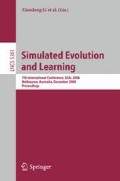Abstract
We describe our efforts to convert (short) DNA sequences obtained from the NCBI library into control sequences for simulated robots by simultaneously evolving both a look up table to assign codons to robot commands and a look up table to assign codons to numerical values that serve as arguments to those commands. Our simulated robot is loosely modeled after the Khepera robot. When the robot’s sensing capabilities are disabled, we are provided with a sophisticated turtle graphics platform. We formulate a fitness function for evaluating the drawings obtained from codon look up tables and we make inter-DNA and intra-DNA comparisons using our evolved tables. Our results suggest that information content can only be weakly extracted from DNA in this way.
Access this chapter
Tax calculation will be finalised at checkout
Purchases are for personal use only
Preview
Unable to display preview. Download preview PDF.
References
Latham, W., Shaw, M., Todd, S., Leymarie, F., Jefferys, B., Kelly, L.: Using dna to generate 3d organic art forms. In: Giacobini, M., Brabazon, A., Cagnoni, S., Di Caro, G.A., Drechsler, R., Ekárt, A., Esparcia-Alcázar, A.I., Farooq, M., Fink, A., McCormack, J., O’Neill, M., Romero, J., Rothlauf, F., Squillero, G., Uyar, A.Ş., Yang, S. (eds.) EvoWorkshops 2008. LNCS, vol. 4974, pp. 433–442. Springer, Heidelberg (2008)
Todd, S., Latham, W.: Evolutionary Art and Computers. Academic Press, London (1992)
Bird, J., Husbands, P., Perris, M., Bigge, B., Brown, P.: Implicit fitness functions for evolving a drawing robot. In: Giacobini, M., Brabazon, A., Cagnoni, S., Di Caro, G.A., Drechsler, R., Ekárt, A., Esparcia-Alcázar, A.I., Farooq, M., Fink, A., McCormack, J., O’Neill, M., Romero, J., Rothlauf, F., Squillero, G., Uyar, A.Ş., Yang, S. (eds.) EvoWorkshops 2008. LNCS, vol. 4974, pp. 473–478. Springer, Heidelberg (2008)
Greenfield, G.: Robot paintings evolved using simulated robots. In: Rothlauf, F., Branke, J., Cagnoni, S., Costa, E., Cotta, C., Drechsler, R., Lutton, E., Machado, P., Moore, J.H., Romero, J., Smith, G.D., Squillero, G., Takagi, H. (eds.) EvoWorkshops 2006. LNCS, vol. 3907, pp. 611–621. Springer, Heidelberg (2006)
Moura, L., Pereira, H.: Man + Robots: Symbiotic Art. Institut d’Art Contemporain, Lyon/Villeurbanne, France (2004)
Moura, L., Ramos, V.: Swarm paintings — nonhuman art. In: Maubant, J. (ed.) Architopia: Book, Art, Architecture, and Science, Lyon/Villeurbanne, France, Institut d’Art Contemporain, pp. 5–24 (2002)
Ramos, V.: Self-organizing the abstract: canvas as a swarm habitat for collective memory, perception and cooperative distributed creativity. In: Rekalde, J. (ed.) First Art & Science Symposium, Models to Know Reality, Bilbao, Spain, p. 59 (2003)
Baluja, S., Pomerleau, D., Jochem, T.: Towards automated artificial evolution for computer-generated images. Connection Science (6), 325–354 (1994)
Greenfield, G.: On the co-evolution of evolving expressions. International Journal of Computational Intelligence and Applications 2(1), 17–31 (2002)
Sims, K.: Artificial evolution for computer graphics. Computer Graphics 25, 319–328 (1991)
Machado, P., Cardoso, A.: Computing aesthetics. In: de Oliveira, F.M. (ed.) SBIA 1998. LNCS (LNAI), vol. 1515, pp. 219–229. Springer, Heidelberg (1998)
Bentley, K.: Exploring aesthetic pattern formation. In: Soddu, C. (ed.) Proceedings of the Fifth International Conference of Generative Art. Alea Press, Milan (2002), http://www.generativeart.com/papersGA2002/20.pdf
Harlan, R., Levine, D., McClarigan, S.: The khepera robot and krobot class: a platform for introducing robotics in the undergraduate curriculum. In: Technical Report 4, St. Bonaventure Undergraduate Robotics Laboratory, St. Bonaventure, NY, St. Bonaventure University (2000)
Greenfield, G.: Evolving aesthetic images using multiobjective optimization. In: Congress on Evolutionary Computation, CEC 2003, Canberra, Australia, New York, NY, December 9-12, pp. 1903–1909. IEEE Press, Los Alamitos (2003)
Author information
Authors and Affiliations
Editor information
Editors and Affiliations
Rights and permissions
Copyright information
© 2008 Springer-Verlag Berlin Heidelberg
About this paper
Cite this paper
Greenfield, G. (2008). Evolved Look-Up Tables for Simulated DNA Controlled Robots. In: Li, X., et al. Simulated Evolution and Learning. SEAL 2008. Lecture Notes in Computer Science, vol 5361. Springer, Berlin, Heidelberg. https://doi.org/10.1007/978-3-540-89694-4_6
Download citation
DOI: https://doi.org/10.1007/978-3-540-89694-4_6
Publisher Name: Springer, Berlin, Heidelberg
Print ISBN: 978-3-540-89693-7
Online ISBN: 978-3-540-89694-4
eBook Packages: Computer ScienceComputer Science (R0)

